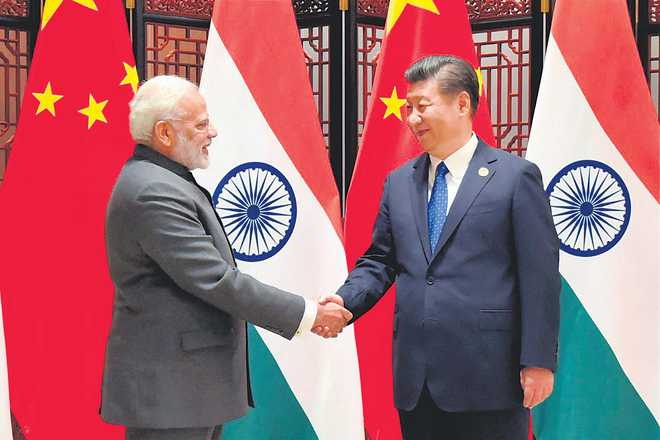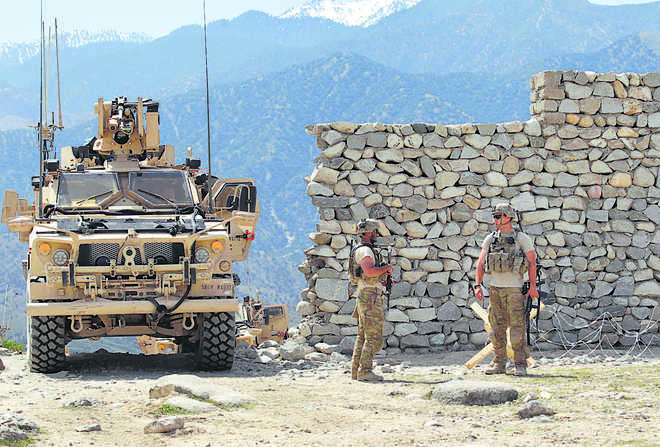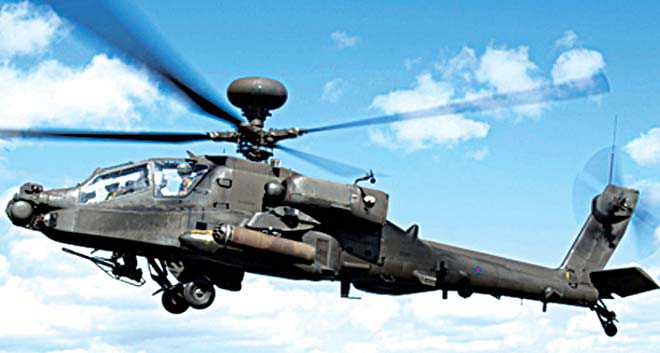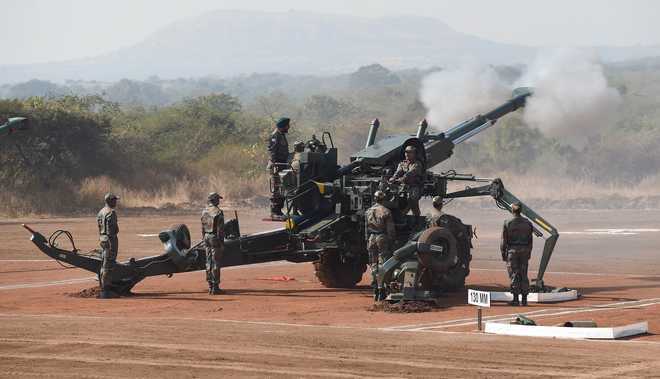Contrary to China’s hope that perhaps India would back off, as the standoff built up, India refused to blink. The global reaction too tended to lean towards India or was neutral.

Prime Minister Narendra Modi meets the President of the People’s Republic of China, Xi Jinping, on the sidelines of the 9th BRICS Summit, in Xiamen, China, recently. PTI
Bhartendu Kumar Singh
WHILE the Doklam crisis has ended, speculation and guesswork continue to masquerade the causes that triggered the crisis. Perceptions and misperceptions overshadow the actual sequence of developments on the ground but there is little doubt that the Chinese leadership wanted to build a road in the disputed area. However, it did eat humble pie, much against its expectations. When the crisis was on, some newspaper articles in India postulated it as another example of (insecure) Chinese nationalism. However, the crisis was neither caused nor precipitated by Chinese nationalism. India actually does not figure high in the Chinese calculus of nationalism. The aggressive posturing by the Global Times (a newspaper perceived to enjoy state support in China) at best represents the microscopic viewpoint. Chinese nationalism is still preoccupied with Japan, the US and Taiwan (to some extent). Throughout the crisis period, there were no mass protests against India as has been the case against Japan and the US in the past, often under state patronage.
Alternative hypotheses
Though there are alternative hypotheses predicting the cause of Doklam, none of them or their combination could be entirely true.1 China was apparently not happy over India’s lack of enthusiasm in the Belt and Road initiative and its non-participation (along with Bhutan) at the inaugural conference in Beijing in May. Doklam could have been a well-thought geopolitical spot to embarrass India since the dispute was primarily with Bhutan. Also, it pinched India right on the Chicken’s Neck, considered as the most sensitive and vulnerable corridor that could cut the Indian mainland from the north-east portion. Thus, Doklam could have been a well-crafted Chinese strategy to inflict ‘revenge’ on India and shore up their own standing in international relations. 2 Doklam could also have been an initiative by President Xi Jinping to consolidate his own position against the collegiate spirit and leadership in the factional politics. This could be very much a probability since most foreign policy crises in China had internal roots. Witness, for example, the 1962 war which was as much about Mao’s personal decision (in order to divert the attention from the great famine deaths) as it was about certain misperceptions between China and India. Many leaders in the Party who could have been Xi’s wanna-be successors have actually been purged recently in the typical Chinese style of anti-corruption crusade. 3 It could have also been a test for China’s military modernisation and strategic consolidation in Tibet. After last year’s reorganisation of the command system in the People’s Liberation Army (PLA), the entire Indian front is against a one-theatre command and China, perhaps, wanted to test its combat-preparedness for local wars. The PLA enjoys considerable influence in Chinese foreign policy decision-making and may have nudged the leadership to check upon its troop movement in Tibet. While the crisis was going on, the PLA conducted a large-scale war exercise near the Line of Actual Control (LAC) in Tibet. Perhaps, the intention was also to gauge the Indian response. In his just-published book, How Statesmen Think — The Psychology Of International Relations (Princeton University Press, 2017), Robert Jervis says that decision-makers are often victims of misleading indicators of military strength and psychological pressures can lead them to run particularly high risks. This is what would have propelled Xi Jinping in playing the risky Doklam game. It is debatable if China gained any advantage from the Doklam crisis. If the Chinese objective was to wage a psychological war, it certainly did not work since India failed to blink. The Chinese whispers of a short and swift military operation to eke out India also did not evoke any panic across the Himalayas. If the objective was to test its war-preparedness in local conditions, it has come at a cost that would surely pinch through negative image building for China in international relations.
BRICS gave exit setting
As the crisis unfolded, India didn’t blink, contrary to China’s expectation. The international reaction was either neutral or inclined in India’s favour. The US and all other great powers refused to toe the Chinese line of posturing, despite China linking the same (at least indirectly) with the North Korean crisis. The crisis only muddled China’s image as a bullying neighbour against its much-hyped “good neighbourly policy” announced in February this year. China’s expectations for a passive aggression strategy had failed. The domination strategy gave way to submission to reality that India will not back off. China perhaps felt the desirability of an exit strategy acceptable to both. The BRICS summit at Xiamen provided the strategic choice environment to China. India is one of the pivotal members of this select club that provides an alternative space for member countries to push their own agenda in international relations. Even a diluted participation from India would have taken the sheen out of summit and exposed internal contradiction in BRICS. The Chinese interlocutors perhaps realised this and kept the diplomatic channels active. Also, the protracted crisis could have become a sore point for the Chinese leadership in the coming Party Congress in October.The writer is in the Indian Defence Accounts Service




























































































































